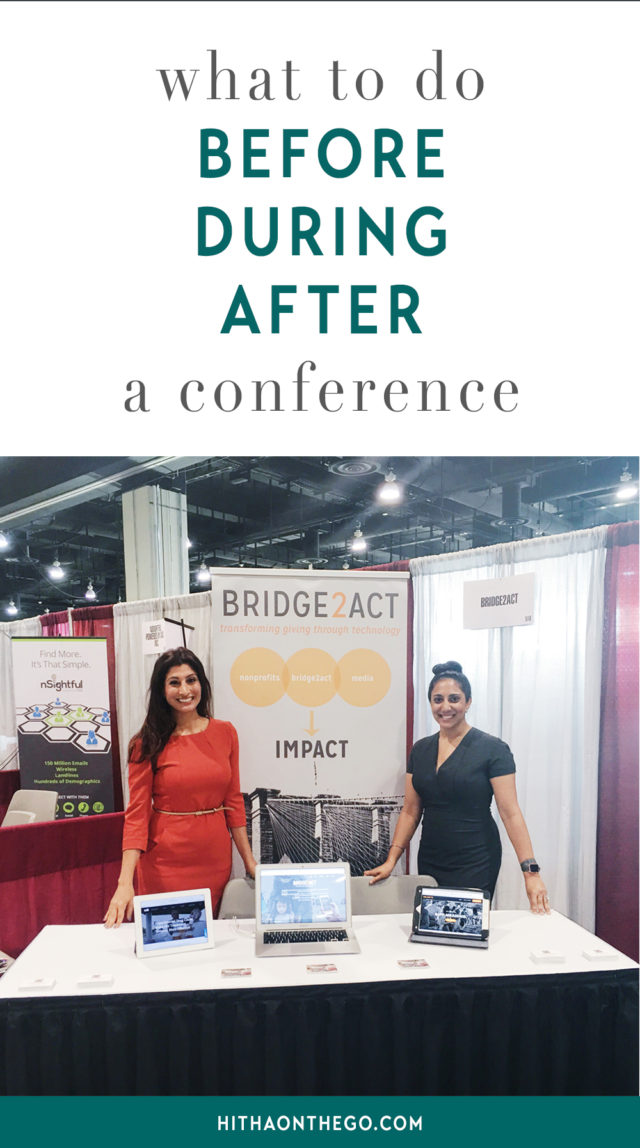
A work conference, like Gwyneth Paltrow and cabbage, are a love-hate thing.
No one is ambivalent about conferences. They either love them, or they loathe them.
I’m firmly in the former camp. Conferences make me wistful for my single days – the possibility of meeting someone new, the chaotic pace, and the promise of a grilled cheese sandwich in room service (versus the late-night diners I used to frequent).
I did meet my husband at a conference (NetIP 2009), so I tend to have a more romantic view of them.
Unlike a single girl’s night out, however, my conference preparations are detailed, thorough, and sober. Whether it was the JPMorgan Healthcare Conference or the recent United State of Women Summit, here’s how I get my conference game face on.
Before the conference
- I dive into the agenda, poring over every panel, speaker, and breakout session. I like to print it out, grab some different colored pens, and mark it up with the people I want to meet, the sessions I want to attend, and if I can squeeze in a chunk of e-mail triage time between the last speaker and the cocktail event.
- 9 times out of 10, the keynote speaker has given a similar speech at another conference. And the speech is floating somewhere in the Internet. You can assume that 80% of the content will probably be the same, so study it and outline a few questions that they probably haven’t heard before. I’ve met David Rubenstein, the patriotic philanthropist, a number of times. At the second conference he spoke at, I jostled my way to the front of the post-speech crowd. My question had nothing to do with pitching my own company or asking about the Magna Carta. Instead, I asked “Who is your favorite founding father?†(Bear in mind this was pre-Hamilton insanity, so it was a unique question).
- Halfway through the conference, I’ll usually hit my limit and need to escape the conference fray. I’ll plan a dinner, either solo or with a friend, that is completely unrelated to the conference. I’ve had many a great meal at the bar of a restaurant, book in one hand and glass of wine in another.Â
During the conference
- A habit I’ve shamelessly stolen from my co-founder is to always sit in the front – and pay attention. Nod. Smile. Take notes (in a notebook). Be engaged. When it’s time for Q&A (and you ALWAYS want to ask a question), you’ll likely be the first to be called on.
- Have your business cards conveniently stashed in 2-3 places – a small case in your bag, inside a jacket pocket, and tucked within your name tag. Once you meet a number of people, quietly excuse yourself and scribble down notes from your conversation on each person’s card – what you discussed, what you want to follow up with them about, the name of their dog. Details matter, as you’ll see below.
- Drink lots of water – a glass or two, every hour. You’re constantly speaking, running from one room to another, and standing. Even if it means frequent bathroom visits, you’ll never regret being well-hydrated at a conference. Plus, you never know who you’ll meet inside the ladies’ room.
After the conference
- Organize all the business cards you collected into the following piles – must follow-up, would be nice to follow up, toss. A good gauge of who you need to follow up with first is how many notes you’ve scribbled on their card. Transfer all the ‘keep’ business cards into a spreadsheet – name, company, title, e-mail address, conversation/follow up notes. Then toss all the cards. If you’re paranoid about missing out on a connection, transfer all the cards into your spreadsheet. I know there are iPhone apps that easily do this, but I prefer this old-school method so I can keep the contacts organized by where I met them.
- When you’re following up after a conference, follow up with purpose – a question to ask, an article you think they’d find interesting, and so on. Skip the “hey, it was great to meet you! Here’s my pitch!†nonsense. People respond to authenticity, and to unsolicited ‘how can I help you?’ notes.
- Schedule your follow up e-mails to go out in the middle of the following week – that way, the people you’re reconnecting with have had a chance to wade through the post-conference slog and are more receptive to receiving an e-mail. Particularly if it’s a note that can help them.
- Plan to follow up again – a few weeks or a month later, if you never received a response (tip – use Boomerang to resend e-mails that don’t receive a reply). Life gets busy. Just be sure to have a strong reason for the e-mail – a recent press hit, their favorite football team having a noteworthy game, or an article you think they’d be interested in.Â
How do you prep for a conference? Do you have any rituals or habits you follow to a T? Share the wealth below!
More #worksmarter tips:
- How to tackle your e-mail,
- Be mentored by anyone
- Work from a coffee shop productively
- Keep up with the news
- How to stay focused on work
thumbnail illustration via

